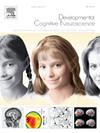Neural, cognitive and psychopathological signatures of a prosocial or delinquent peer environment during early adolescence
IF 4.9
2区 医学
Q1 NEUROSCIENCES
引用次数: 0
Abstract
Adolescence is a critical period for brain development, yet the impact of peer environments on brain structure, cognition, and psychopathology remains poorly understood. Here, we capitalized on data from 7806 adolescents (age = 12.02 ± 0.67) from the Adolescent Brain Cognitive Development (ABCD) study, to determine associations between two distinct peer environments (proportion of prosocial or delinquent friends) and the structural and functional architecture of the brain, cognition, as well as behavioral and emotional dysregulation. A higher proportion of prosocial friends was associated with fewer behavioral problems and larger fronto-cingulate and striatal regions. In contrast, a higher proportion of delinquent friends was linked to increased behavioral problems, lower neurocognitive performance, and decreased functional connectivity in the default-mode and fronto-striato-limbic circuits, which spatially overlapped with external dopamine density maps. Moreover, the associations between prosocial friends and behaviors were mediated by brain volumes (e.g., pallidum), while the associations between delinquent friends and behaviors were primarily mediated by fronto-striato-limbic connectivity. Prosocial friends also attenuated the development of internalizing problems, whereas delinquent friends promoted externalizing symptoms. These findings underscore the profound influence of peer environments on adolescent brain development and mental health, highlighting the need for early interventions to promote resilience and healthy neuro-maturation.
青少年早期亲社会或不良同伴环境的神经、认知和精神病理特征
青少年是大脑发育的关键时期,然而同伴环境对大脑结构、认知和精神病理的影响仍然知之甚少。在这里,我们利用了来自青少年大脑认知发展(ABCD)研究的7806名青少年(年龄= 12.02 ± 0.67)的数据,以确定两种不同的同伴环境(亲社会或不良朋友的比例)与大脑结构和功能结构、认知以及行为和情绪失调之间的关系。亲社会朋友的比例越高,行为问题越少,额扣带和纹状体区域越大。相反,不良朋友的比例越高,行为问题越严重,神经认知能力越低,默认模式和额纹状体边缘回路的功能连性越差,这与外部多巴胺密度图在空间上重叠。此外,亲社会朋友与行为之间的关联主要由脑容量(如苍白质)介导,而不良朋友与行为之间的关联主要由额-纹状体-边缘连接介导。亲社会的朋友也减轻了内化问题的发展,而不良的朋友则促进了外化症状的发展。这些发现强调了同伴环境对青少年大脑发育和心理健康的深远影响,强调了早期干预以促进恢复力和健康的神经成熟的必要性。
本文章由计算机程序翻译,如有差异,请以英文原文为准。
求助全文
约1分钟内获得全文
求助全文
来源期刊

Developmental Cognitive Neuroscience
NEUROSCIENCES-
CiteScore
7.60
自引率
10.60%
发文量
124
审稿时长
6-12 weeks
期刊介绍:
The journal publishes theoretical and research papers on cognitive brain development, from infancy through childhood and adolescence and into adulthood. It covers neurocognitive development and neurocognitive processing in both typical and atypical development, including social and affective aspects. Appropriate methodologies for the journal include, but are not limited to, functional neuroimaging (fMRI and MEG), electrophysiology (EEG and ERP), NIRS and transcranial magnetic stimulation, as well as other basic neuroscience approaches using cellular and animal models that directly address cognitive brain development, patient studies, case studies, post-mortem studies and pharmacological studies.
 求助内容:
求助内容: 应助结果提醒方式:
应助结果提醒方式:


